A) Owl populations frequent the area more often because of increased hunting success.
B) Females undergo hormonal changes that delay sexual maturation, and many individuals suffer depressed immune systems and die due to the stress of overpopulation.
C) Clumped dispersion of the population leads to increased spread of disease and parasites, resulting in a population crash.
D) All of the resources (food and shelter) are used up by overpopulation, and much of the population dies of exposure and/or starvation.
F) C) and D)
Correct Answer

verified
Correct Answer
verified
Multiple Choice
Scientific study of the population cycles of the snowshoe hare and its predator, the lynx, has revealed that
A) predation is the dominant factor affecting prey population cycling.
B) hares and lynx are so mutually dependent that each species cannot survive without the other.
C) both hare and lynx population sizes are affected mainly by abiotic factors.
D) the hare population is r-selected and the lynx population is K-selected.
F) A) and C)
Correct Answer

verified
Correct Answer
verified
Multiple Choice
Use the graph to answer the following question.
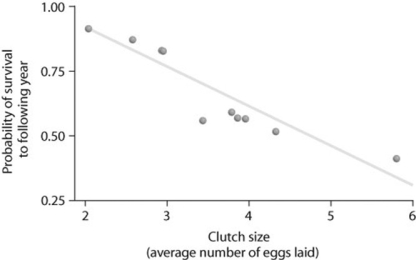 Looking at the data in the figure, what can be said about survival and clutch size?
Looking at the data in the figure, what can be said about survival and clutch size?
A) Animals with low survival tend to have smaller clutch sizes.
B) Large clutch size correlates with low survival.
C) Animals with high survival tend to have medium-sized clutches.
D) Probability of survivorship does not correlate with clutch size.
F) A) and B)
Correct Answer

verified
Correct Answer
verified
Multiple Choice
Use the figure to answer the following question. Life Table for Zootoca vivipara in the Netherlands Data are from Strijbosch and Creemers, 1988. Using the table, how would you describe the population dynamics of the Eurasian lizard, Z. vivipara?
A) The population is increasing.
B) The population is decreasing.
C) The population is stable.
D) The table does not provide this information.
F) A) and C)
Correct Answer

verified
A
Correct Answer
verified
Multiple Choice
Use the survivorship curves in the figure to answer the following question.
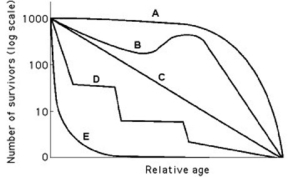 Which curve best describes survivorship in marine mollusks?
Which curve best describes survivorship in marine mollusks?
A) A
B) B
C) C
D) E
F) A) and C)
Correct Answer

verified
Correct Answer
verified
Multiple Choice
Which of the following groups would be most likely to exhibit uniform dispersion?
A) red squirrels, who actively defend territories
B) cattails, which grow primarily at edges of lakes and streams
C) dwarf mistletoes, which parasitize particular species of forest tree
D) lake trout, which seek out cold, deep water high in dissolved oxygen
F) B) and C)
Correct Answer

verified
Correct Answer
verified
Multiple Choice
Which of the following causes populations to shift most quickly from an exponential to a logistic population growth?
A) favorable climatic conditions
B) removal of predators
C) decreased death rate
D) competition for resources
F) A) and B)
Correct Answer

verified
Correct Answer
verified
Multiple Choice
Starting from a single individual, what is the size of a population of bacteria at the end of a 2-hour time period if they reproduce by binary fission every 20 minutes? (Assume unlimited resources and no mortality.)
A) 16
B) 32
C) 64
D) 128
F) B) and C)
Correct Answer

verified
Correct Answer
verified
Multiple Choice
Use the figure to answer the following question.
 Looking at the data in the figure from the hare/lynx experiment, what conclusion(s) can you draw?
I.Food is a factor in controlling hare population size.
II.Excluding lynx is a factor in controlling hare population size.
III.The effect of excluding predators and adding food in the same experiment is greater than the sum of excluding lynx alone plus adding food alone.
Looking at the data in the figure from the hare/lynx experiment, what conclusion(s) can you draw?
I.Food is a factor in controlling hare population size.
II.Excluding lynx is a factor in controlling hare population size.
III.The effect of excluding predators and adding food in the same experiment is greater than the sum of excluding lynx alone plus adding food alone.
A) only I
B) only II
C) only III
D) I, II, and III
F) A) and B)
Correct Answer

verified
Correct Answer
verified
Multiple Choice
Use the graph to answer the following question.
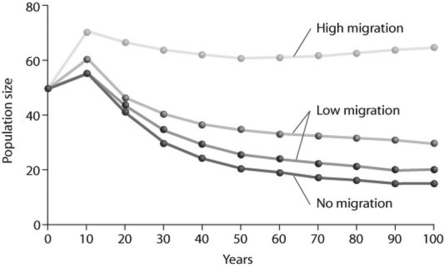 Looking at the figure, what factor is contributing significantly to stabilizing the population size over time?
I.no migration
II.low migration
III.high migration
Looking at the figure, what factor is contributing significantly to stabilizing the population size over time?
I.no migration
II.low migration
III.high migration
A) only I
B) only II
C) only III
D) only II and III
F) A) and C)
Correct Answer

verified
Correct Answer
verified
Multiple Choice
Based on current growth rates, Earth's human population in 2019 will be closest to
A) 2.5 million.
B) 4.5 billion.
C) 7.5 billion.
D) 10.5 billion.
F) None of the above
Correct Answer

verified
Correct Answer
verified
Multiple Choice
Natural selection involves energetic trade-offs between ________.
A) choosing how many offspring to produce over the course of a lifetime and how long to live
B) producing large numbers of gametes when employing internal fertilization versus fewer numbers of gametes when employing external fertilization
C) increasing the number of individuals produced during each reproductive episode and a corresponding decrease in parental care
D) high survival rates of offspring and the cost of parental care
F) A) and C)
Correct Answer

verified
Correct Answer
verified
Multiple Choice
The observation that members of a population are uniformly distributed suggests that
A) resources are distributed unevenly.
B) the members of the population are competing for access to a resource.
C) the members of the population are neither attracted to nor repelled by one another.
D) the density of the population is low.
F) C) and D)
Correct Answer

verified
Correct Answer
verified
Multiple Choice
An ecologist recorded 12 white-tailed deer, Odocoileus virginianus, per square kilometer (km²) in one woodlot and 20 km² in another woodlot. What was the ecologist comparing?
A) density
B) dispersion
C) carrying capacity
D) range
F) B) and C)
Correct Answer

verified
Correct Answer
verified
Multiple Choice
Use the graphs to answer the following question.
(a)
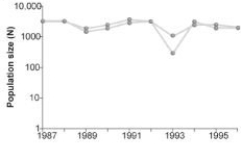 (b)
(b)
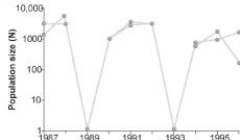 Graph (b) in the figure shows the normal fluctuations of a population of grouse, a ground-nesting bird. Assuming graph (a) in the figure is the result of some experimental treatment in the grouse population, what can be concluded?
Graph (b) in the figure shows the normal fluctuations of a population of grouse, a ground-nesting bird. Assuming graph (a) in the figure is the result of some experimental treatment in the grouse population, what can be concluded?
A) The experimental treatment intensified the population cycling.
B) The experimental treatment did not affect population cycling in this species.
C) The experimental treatment has most likely identified the cause of population cycling.
D) The experimental treatment involved the introduction of a predator of the bird.
F) None of the above
Correct Answer

verified
Correct Answer
verified
Multiple Choice
Use the survivorship curves in the figure to answer the following question.
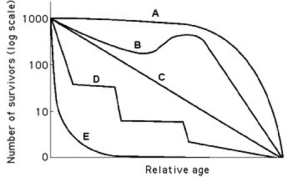 Which curve best describes survivorship in elephants?
Which curve best describes survivorship in elephants?
A) A
B) B
C) C
D) E
F) B) and C)
Correct Answer

verified
A
Correct Answer
verified
Multiple Choice
During exponential growth, a population always ________.
A) grows at its maximum per capita rate
B) quickly reaches its carrying capacity
C) adds more new individuals when the population is small than when it is large
D) loses some individuals to emigration
F) B) and C)
Correct Answer

verified
Correct Answer
verified
Multiple Choice
Which of the following graphs illustrates the population growth curve starting with a single bacterium growing in a flask of ideal medium at optimum temperature over a two-hour period? Assume resources do not become limiting over this time frame.
A) ![]()
B) ![]()
C) ![]()
D) ![]()
F) B) and D)
Correct Answer

verified
Correct Answer
verified
Multiple Choice
Which of the following statements regarding the future of populations in developing, less industrialized countries are correct? I.The reproductive rates are predicted to remain below replacement level. II.Survivorship will increase. III.Overall population size will increase dramatically. IV.The fertility rate is predicted to remain high, especially in some regions.
A) only I and III
B) only II and IV
C) only II, III, and IV
D) only I, II, and III
F) None of the above
Correct Answer

verified
Correct Answer
verified
Multiple Choice
Use the figure to answer the following question.
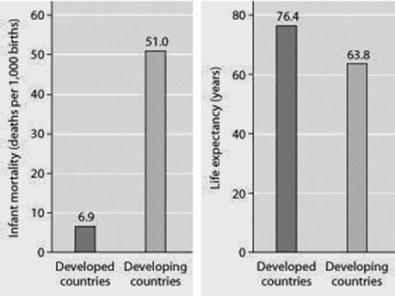 Infant mortality and life expectancy at birth in developed and developing countries (data as of 2005) .
What is a logical conclusion that can be drawn from the graphs? Developed countries have ________.
Infant mortality and life expectancy at birth in developed and developing countries (data as of 2005) .
What is a logical conclusion that can be drawn from the graphs? Developed countries have ________.
A) lower infant mortality rates and lower life expectancy than developing countries
B) higher infant mortality rates and lower life expectancy than developing countries
C) lower infant mortality rates and higher life expectancy than developing countries
D) higher infant mortality rates and higher life expectancy than developing countries
F) B) and D)
Correct Answer

verified
C
Correct Answer
verified
Showing 1 - 20 of 69
Related Exams